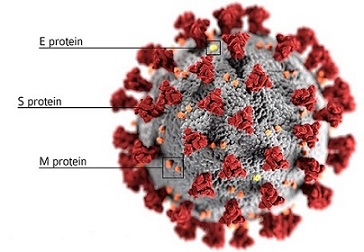COVID-19 News: SARS-CoV-2 E Protein Induces Inflammatory Response And Monocyte Pyroptosis Which Can Be Reversed By Ruscogenin
COVID-19 News - SARS-CoV-2 E Proteins - Pyroptosis Mar 19, 2023 2 years, 3 weeks, 4 days, 11 hours, 51 minutes ago
COVID-19 News: A new study by researchers from Nanchang University-China, The Second Affiliated Hospital of Nanchang-China, Hainan General Hospital-China and University of Missouri Kansas City-USA has found that the SARS-CoV-2 E protein induces inflammatory response and monocyte pyroptosis which can be reversed by Ruscogenin.

Ruscogenin is an anti-inflammatory steroid and is actually a phytochemical extracted from the butcher's broom (ruscus aculeatus) plant that has been found in numerous clinical studies to have a variety of health benefits and medical uses.
SARS-CoV-2, an emerging pathogenic coronavirus, has been reported to cause excessive inflammation and dysfunction in multiple cells and organs, but the underlying mechanisms remain largely unknown.
The study team showed exogenous addition of SARS-CoV-2 envelop protein (E protein) potently induced cell death in cultured cell lines, including THP-1 monocytic leukemia cells, endothelial cells and bronchial epithelial cells, in a time- and concentration-dependent manner. SARS-CoV-2 E protein caused pyroptosis-like cell death in THP-1 and led to GSDMD cleavage.
Also, it was found that SARS-CoV-2 E protein up-regulated the expression of multiple pro-inflammatory cytokines that may be attributed to activation of NF-kappaB, JNK and p38 signal pathways.
Notably, the study findings identified a natural compound, Ruscogenin, effectively reversed E protein-induced THP-1 death via inhibition of NLRP3 activation and GSDMD cleavage.
The study findings suggest that Ruscogenin may have beneficial effects on preventing SARS-CoV-2 E protein-induced cell death and might be a promising treatment for the complications of COVID-19.
The study findings were published in the peer reviewed journal: Biochemistry and Cell Biology.
https://cdnsciencepub.com/doi/10.1139/bcb-2022-0359
Numerous viral proteins from SARS have been examined for their interactions with host cells, which can facilitate viral survival and replication or disrupt immune balance. It remains to be determined if SARS-CoV-2 viral components serve a similar function during infection.
Cell death, a typical consequence of virus-infected host cells, can sometimes hinder viral invasion and replication. However, in many instances, it disrupts cellular equilibrium and triggers excessive inflammation, leading to tissue and organ failure or even death.
Pyroptosis is an inflammatory, lytic form of programmed cell death characterized by cell swelling and ballooning. This process is mediated by the gasdermin (GSDM) protein family, which can be activated and cleaved by the caspase protein family or other proteases. The N-fragment of GSDM proteins can insert into membranes, forming pores that compromise plasma membrane integrity and release intracellular contents. IL-1β and IL-18 are critical pro-inflammatory mediators released during pyroptosis-associated inflammation.
Monocytes, a type of myeloid cell, play a crucial role in producing inflammatory cytokines during inflammation and are necessary for processing and secreting IL-1 family cytokines. Recent studies have shown active NLRP3 inflammasomes in various samples, with certain serum levels correlating with COVID-19 seve
rity. SARS-CoV-2 has also been found to activate inflammasomes and cause pyroptosis in human primary monocytes, resulting in an inflammatory response. However, the specific factors that activate monocytes and induce inflammatory cytokines during SARS-CoV-2 infection are still unclear, and further research is needed to understand the role of the virus's components in this process.
The envelope protein (E protein) of coronaviruses is the smallest of the major structural proteins, capable of oligomerizing to form viroporin, a transmembrane ion channel.
A study on the SARS-CoV E protein revealed that it formed a calcium-permeable ion channel, causing calcium leakage from ERGIC/Golgi membranes, disrupting ion homeostasis, and activating the NLRP3 inflammasome, potentially exacerbating the condition.
The ion channel activity of the E protein may play a significant role in driving NLRP3-associated immune responses in infected cells. However, no direct evidence confirms similar activity in the SARS-CoV-2 E protein, even though the structural binding motifs are highly conserved between SARS-CoV and SARS-CoV-2.
This study offers new insights into the interactions between the SARS-CoV-2 virus and host cells, particularly how the virus's envelope (E) protein triggers pyroptosis and an inflammatory response in THP-1 cells through the TLR2/NF-κB signaling pathway. Researchers identified Ruscogenin, a natural compound, as a potential therapy for COVID-19 and related complications by alleviating E protein-induced pyroptosis in THP-1 cells.
Past studies and
COVID-19 News coverages have shown that the E protein is conserved between SARS-CoV and SARS-CoV-2 and can induce cell death and organ injury.
The current study established an in vitro model to explore the interaction between E protein and immune cells, revealing that E protein interacts with the membrane receptor TLR2, leading to the activation of pro-inflammatory pathways and pyroptosis.
Cytokine storms, caused by an excessive release of cytokines, are a significant factor in COVID-19 severity, leading to acute respiratory distress syndrome (ARDS) and systemic inflammatory response syndrome (SIRS). Monocytes, a type of immune cell, play a crucial role in inflammation and cytokine storm development.
Although the direct infection of monocytes by SARS-CoV-2 is still unclear, the study suggests that E protein's toxic effects on pyroptosis and inflammation contribute to the cytokine storm and immune escape in COVID-19 patients. The NLRP3 inflammasome, an essential part of innate immunity and inflammation, has been linked to COVID-19 severity.
Various viral proteins, including the E protein, can activate the NLRP3 inflammasome through direct interactions or by triggering ion channel changes. The study demonstrated that Ruscogenin effectively inhibited E protein-induced pyroptosis by downregulating NLRP3 expression, possibly through NF-κB inhibition. This finding suggests that Ruscogenin could be a promising strategy for treating COVID-19 patients.
In conclusion, the study sheds light on the mechanisms of SARS-CoV-2-induced systemic inflammation and multi-organ injury, with the E protein functioning as a lethal toxin that induces an inflammatory response and monocyte pyroptosis. The natural compound Ruscogenin was found to alleviate E protein-induced pyroptosis by inhibiting NLRP3 inflammasome activation, offering a potential therapeutic strategy for COVID-19 patients. Further research is needed to understand the precise interactions between the E protein and NLRP3.
For the latest
COVID-19 News, keep on logging to Thailand Medical News.
